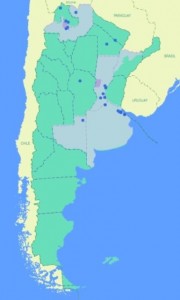While looking for something else, I came across an interesting food timeline. Perhaps a bit selective, but definitely worth exploring. Then by coincidence I stumbled on another timeline, this time of gardening around the world. Again, not a bad way to waste some time, although way too many links seem to be broken. Anyway, I naturally tried to go for the trifecta, but I could not find an even half-decent timeline of agricultural history. Maybe you can?
Nibbles: Caucasus, Quillaja saponaria, Cococnut picker
- Endangered Caucasian plants discussed. Presumably that will include CWR.
- Bark of Chilean endemic Quillay tree preserves chicken meat.
- “We call upon anyone to develop a product that can be used to pluck coconuts [while] standing on the ground. Anyone wanting to go ahead with this should submit a design and if it is approved they will be given Rs 1,000,000 to develop this product.”
Nibbles: Pluots, Village chickens, Axolotl, Artisanal fishing, Fruit and climate change, Stamps, Hornless cattle, Artemisin for malaria, Aquatic agroecosystems characterization, Speciation and ploidy
- What’s the difference between pluots and plumcots? By the guy who wrote the book.
- ACIAR publication on village chickens, and another. Thanks, DAD-Net.
- Modeling the axolotl, the edible Mexican salamander, before it’s too late.
- Artisanal fishing data. Via.
- USDA looking to expand its fruit collection to cope with climate change. NOt the only ones, I imagine.
- Danes stamp on allotments. No, wait. Allotments on Danish stamps.
- Aussies find genetic marker for hornless cattle that will jump on barbie by themselves.
- Breeding better Artemisia annua.
- The diversity of farmer-managed aquatic systems in SE Asia.
- 15% of angiosperm speciation events are accompanied by ploidy increase. Much more in domesticated species, I bet.
Mapping Argentinian pests and diseases
The Instituto Nacional de Tecnología Agropecuaria in Argentina has a new online pest and disease atlas out. It’s in Spanish, but pretty intuitive to use. You can search by host or by pest/disease organism. And you get a bunch of references, descriptive notes, photos and a map, albeit a static one — not sure how updating will be done. Below is the distribution of Setosphaeria turcica, the causal agent of Northern Leaf Blight in corn, for example. Would be interesting to mash this kind of thing up with the distribution of tolerant material. Must look into that. And of course one could do some climate change prediction modeling too. Thanks to IIALD.

Getting to the bottom of potato late blight resistance
There’s a bit of an argy-bargy developing in the comments to Robert’s provocative post Inorganic farming. Anastasia raised the question of transgenics for fungal resistance, which Robert echoed. Patrick then waded in bullishly to ask why transgenics were needed, when breeder Tom Wagner “has created quite a number of potato lines totally resistant to late blight”. And that created a clamour from Robert to the effect that he couldn’t find any evidence of Wagner’s success on this front.
Two points.
First, although Patrick was perhaps too modest to say so, he has arranged for Tom Wagner to be at a meeting in Oxford, England, as part of a Greater European Tour that Tom is undertaking in the autumn. So anyone who wants to know about his selections for late blight resistance can get it straight from the horse’s mouth. And report it here, please.
Secondly, don’t panic. Scientists at the University of Dundee in Scotland and elsewhere have discovered a single gene that, they say, is the key to blight resistance. “We are really excited by the discovery of RXLR. This has provided a signature to search for proteins that are delivered inside host cells, where they may be exposed to plant defence surveillance systems,” said Professor Paul Birch, the team leader. Clearly it won’t be long before the threat of late blight is a thing of the past.